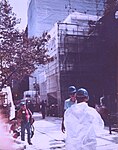18th Street station (IRT Third Avenue Line)
1955 disestablishments in New York (state)Defunct New York City Subway stations located abovegroundFormer elevated and subway stations in ManhattanIRT Third Avenue Line stationsManhattan railway station stubs ... and 3 more
Pages with no open date in Infobox stationRailway stations closed in 1955Third Avenue

18th Street was a local station on the demolished IRT Third Avenue Line in Manhattan, New York City. The center track was built as part of the Dual Contracts and bypassed the station and served express trains. This station closed on May 12, 1955, with the ending of all service on the Third Avenue El south of 149th Street.
Excerpt from the Wikipedia article 18th Street station (IRT Third Avenue Line) (License: CC BY-SA 3.0, Authors, Images).18th Street station (IRT Third Avenue Line)
East 18th Street, New York Manhattan
Geographical coordinates (GPS) Address Nearby Places Show on map
Geographical coordinates (GPS)
| Latitude | Longitude |
|---|---|
| N 40.73575 ° | E -73.985277777778 ° |
Address
Park Towers Apartments
East 18th Street
10003 New York, Manhattan
New York, United States
Open on Google Maps








